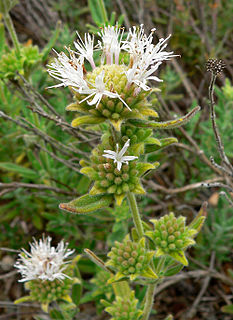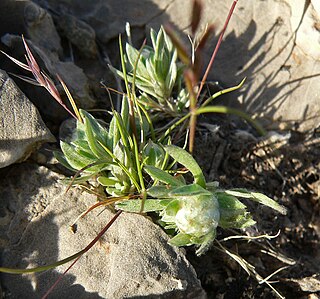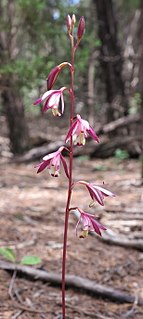
Pinus ponderosa, commonly known as the ponderosa pine, bull pine, blackjack pine, western yellow-pine, or filipinus pine is a very large pine tree species of variable habitat native to mountainous regions of western North America. It is the most widely distributed pine species in North America.

Hexalectris is a genus of the family Orchidaceae, comprising 10 known species of fully myco-heterotrophic orchids. These species are found in North America, with the center of diversity in northern Mexico. None of the species are particularly common. Hexalectris spicata has a wide distribution and is likely the most abundant member of the genus, but is nevertheless infrequent throughout its range. Other species are rare, and some, such as H. colemanii, are threatened or endangered. All species that have been studied form associations with ectomycorrhizal fungi that are likely linked to surrounding trees. Many Hexalectris species are found in association with oak trees (Quercus), which are ectomycorrhizal.

Monardella is a genus of approximately 40 species of annual and perennial plants native to western North America from British Columbia to northwestern Mexico. They are grown for their highly aromatic foliage, which in some species is used for herbal teas. The two-lipped, tubular flowers are formed in terminal clusters and are most usually red, pink, or purple.

Opuntia gosseliniana, commonly known as the violet pricklypear, is a species of cactus that is native to Pima County, Arizona in the United States and Baja California, Chihuahua, and Sonora in Mexico.

Ferocactus cylindraceus is a species of barrel cactus which is known by several common names, including California barrel cactus, Desert barrel cactus, and miner's compass. It was first described by George Engelmann in 1853.

Stylocline(neststraw) is a small genus of North American desert plants in the tribe Gnaphalieae within the family Asteraceae.

Deinandra is a genus of flowering plants in the tribe Madieae within the family Asteraceae. Such a genus is not recognized as distinct by all authorities; its species are often treated as members of the genus Hemizonia.

Piptochaetium, or speargrass, is a genus of New World plants in the grass family, native to North and South America. Piptochaetium is a bunchgrass genus in the tribe Stipeae.
Parthenice is a genus of flowering plants in the family Asteraceae.

Poa secunda is a widespread species of perennial bunchgrass native to North and South America. It is highly resistant to drought conditions, and provides excellent fodder; and has also been used in controlling soil erosion, and as revegetator, often after forest fires. Cultivars include 'Canbar', 'Service', 'Sherman', and 'Supernova'. Historically, indigenous Americans, such as the Gosiute of Utah, have used P. secunda for food. It was originally described botanically in 1830 by Jan Svatopluk Presl, from a holotype collected from Chile by Thaddäus Haenke in 1790.

Pholisma arenarium is a species of flowering plant in the borage family known by several common names, including desert Christmas tree, scaly-stemmed sand plant, and purple sand food. As the name implies, the loaf-like part of the root is edible. It is native to northwestern Mexico, Arizona and southern California, where it grows in many habitat types, including desert, chaparral, and sandy coastal dunes. It is a fleshy perennial herb taking a compact cylindrical or ovate shape up to 20 or 30 centimeters tall above ground, often with part of the stem below the sandy surface. It is a parasitic plant growing on the roots or of various shrubs such as burrobush, Yerba Santa, California croton, rabbitbrush, and ragweeds. As a heterotroph which derives its nutrients from other plants, it lacks chlorophyll and is brownish-gray or whitish in color. There are hairy, glandular, pointed leaves along the surface of the plant. Flowers emerge between them, each roughly one centimeter wide, the rounded corolla lavender to deep or bright purple with a white margin.

Platanthera colemanii is a rare species of orchid known by the common names Coleman's piperia and Coleman's rein orchid. It is endemic to California, where it is known from scattered occurrences along the Sierra Nevada and one disjunct location in Colusa County, California. It grows in coniferous forests and chaparral in deep sandy substrates. It was differentiated from the very similar Platanthera unalascensis in 1993.

Graptopetalum bartramii is a species of succulent plant known as Bartram's stonecrop and Patagonia Mountain leatherpetal.

Hexalectris spicata, the spiked crested coralroot, is a terrestrial, myco-heterotrophic orchid lacking chlorophyll and subsisting entirely on nutrients obtained from mycorrhizal fungi in the soil. It is native to Arizona, New Mexico, Texas and Coahuila. It is closely related to H. arizonica and the two are sometimes considered varieties of the same species. Hexalectris spicata is endemic to the southern half of the United States from Arizona east to Florida and north to Maryland and the Ohio Valley.
Hexalectris revoluta, the Chisos Mountain crested coralroot, is a terrestrial, myco-heterotrophic orchid lacking chlorophyll and subsisting entirely on nutrients obtained from mycorrhizal fungi in the soil. It is closely related to H. colemanii; the two are regarded by some authors as varieties of the same species. Hexalectris revoluta is native to western Texas, southeastern New Mexico and Chihuahua.
Coreocarpus arizonicus, the little lemonhead, is a North American species of flowering plants in the daisy family native to northwestern Mexico and the southwestern United States. It has been found in southern Arizona, and in the adjacent Mexican States of Sonora, Chihuahua, Sinaloa, and Baja California Sur.

Heterotheca rutteri, the Huachuca goldenaster or Rutter's false goldenaster, is a rare North American species of flowering plant in the family Asteraceae. It has been found only in the Huachuca and Santa Rita Mountains of southern Arizona and northern Sonora.
Quercus viminea, the Sonoran oak, or Mexican willow oak, is a North American species of oak. It is native to northwestern and west-central Mexico, primarily in the Sierra Madre Occidental. The species range extends just north of the international border into Santa Cruz County in southern Arizona.

Hexalectris warnockii, the Texas crested coralroot, Texas purple-spike, is a myco-heterotrophic orchid found in the states of Texas and Arizona in the southwestern United States, and in the states of Coahuila and Baja California Sur in northern Mexico. Being myco-heterotrophic, H. warnockii derives all of its nutrients from mycorrhizal fungi.

Rhododendron colemanii, the Red Hills azalea, is a species of Rhododendron native to the upper coastal plain of Alabama and western Georgia in the United States. This species was previously confused with Rhododendron alabamense and its hybrids, but was distinguished by DNA sequencing.














